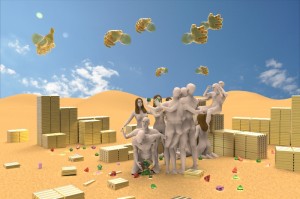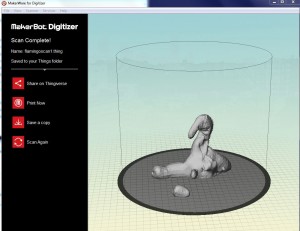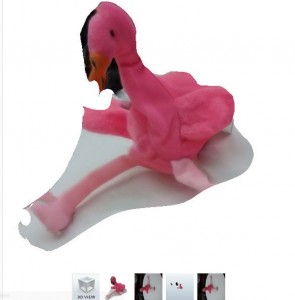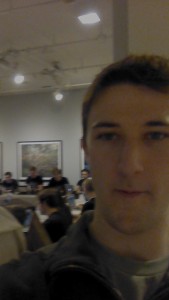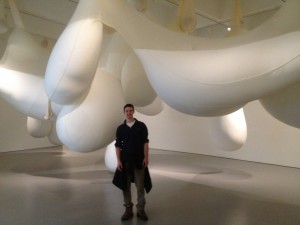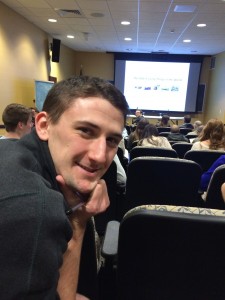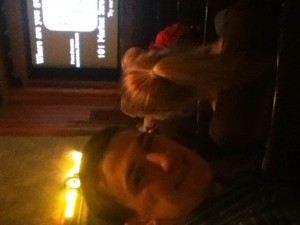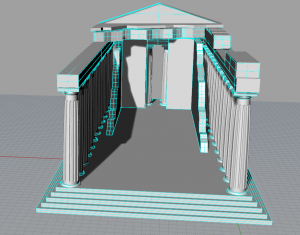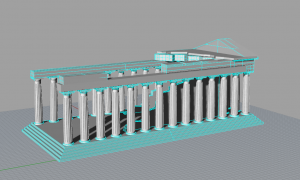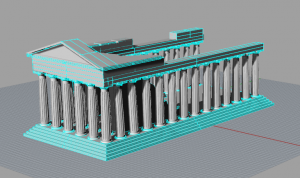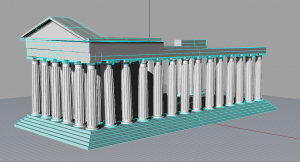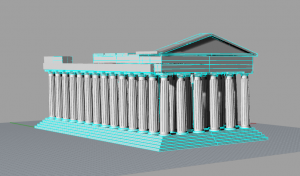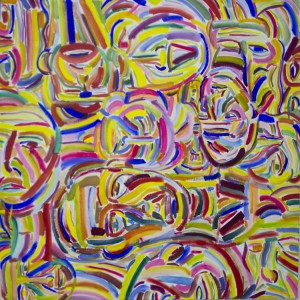Author: fws006
Project 3- Eric
What question/problem did you choose?
What is hell?
Tell why you chose this topic and why it matters to you.
When most people think of hell, any number of grotesque, horrifying images come to mind. Demons. Worms. Skeletons. Darkness. Flames. All things that contribute to an eternal sentence of unimaginable torture for those who reject God. But could a loving God really create such a place, let alone condemn his own creations to live there? This conundrum is one that may turn people away from Him, and even religion in general. To me, these commonly accepted depictions of hell seem outlandish and over-the-top.
Give some details on the problem/question—explain it in depth.
“The mind is its own place, and in itself can make a heaven of hell, a hell of heaven.”
-John Milton, Paradise Lost
I would like to create a project that explores what Hell really is, and perhaps, why it even exists in the first place. As a Catholic, the depictions of Hell as a place of physical torture makes little sense to me. From my understanding, Hell is less of a place, and more of a state. Without getting caught up in the physical images that are obviously meant to be figurative (after all, how can a place of utter darkness be covered in glowing flames?), I want to create a series of digital images that more accurately depict the state that Hell is meant to represent: one of immense loneliness and rejection, defined by the absence of God. I want to show the essence of Hell being relational, not physical. It is a “place” where its inhabitants lifetime of choosing to reject God’s love eventually come to the realization of what they have lost. I want to show the utter heartbreak, the lifelessness that comes with this eternal state of being. God has given us the dignity to live our lives how we want to, but if we constantly defy him, making ourselves the centers of our universe, than that is exactly how our souls will spend eternity in Hell.
List out 10 tangible people/places/things that are associated with your question/problem.
- Inferno
- Circles of Hell
- Pride
- Gluttony
- Lust
- Greed
- Throne
- Time Out Corner
- Island
- Desert
Fallen Angel by Damien Lovegrove
I would like to invoke a similar feeling of inner isolation as this photo depicts. The void is even more recognizable in that it is in black and white, which I might want to use in my project.
Project 2- Growing Old Together – Eric
Thanks to the rise of popular smart phone apps like Tinder, Hinge, and Friendsy, online dating has become more and more common over the last few years. Of course, there is still a stigma associated with these apps, a slight sense of shame in the presumption that one couldn’t just go out and meet someone in the real world. However, in the post-human era, this stigma will dissolve, as online dating will reveal itself as a much more efficient way of finding the ideal mate, through advanced search engines and match-making algorithms. Further still, technology is developing to the point where entire sexual relationships can theoretically be maintained without ever meeting, replaced instead by a combination of customizable bots, remote controlled pleasure giving devices called teledildonics, and virtual sex simulators using Haptic technology. For now, those with a preference for this sort of relationship are stigmatized as being “Internet-Sexual”, but perhaps we are not far off from a point where growing old with a synthetically-built significant other will not be uncommon.
3D Scanning Exercises- Eric
3D Scanning Exercises- Eric
The digitizer didn’t work too great, it kept disconnecting itself for no reason, but once it finally scanned, I was left with a decently workable (if not too lumpy) 3D. I am unsure why the flamingo’s left leg got chopped off.
Only one side of the flamingo seemed to scan in a recognizable way. Everything else was way too twisted and flat. I tried increasing the number of photos but I was limited to only 12 on the app. The app would often crash or tell me that a scan could not be made.
My Face Scan came out excellently. I may have just been lucky but I was able to get a very workable mesh from these scans, and they weren’t even too lumpy. The only thing is I can ‘t figure out how to get the photographic information (colors, etc.) to export with the mesh.
Blyn Response- Eric
When Blyn suggest that we have entered a posthuman era, I think that she means we are beginning to transcend that which makes us human. There are several examples in today’s society of figures who have gone beyond our standard biological specifications and currently exist in a state that is beyond. I think that as we are only just beginning to enter this era, the features of what makes something posthuman are not clearly defined, but they are easy to spot when confronted with face to face. Something like being able to change one’s gender through a surgical process may fall under the posthuman umbrella. The other example Blyn gives is Aimee Mullins, a double amputee with glass prostheses. I thought it was very interesting how Mullins has managed to spin what was once seen as a disability into perhaps her greatest asset. She suddenly has the ability to mold her identity through her physical features, swapping her legs at will to suit her environment. This blows me away! I think overall, the ability to transform our bodies in a way that, while not entirely natural, gives us new abilities is an incredible positive leap for our species. As someone constantly dealing with injuries and illnesses that hinder my capabilities, I would love to swap out my tendinitis-ridden foot with a sleek, pain-free glass one. Once this type of augmenting the body becomes more widespread, will the posthuman become human? The corporate domination is one of the few negatives I can think of coming from this, but it would be no different from how corporations run all other aspects of our lives. They control the types of food we eat, the clothes we wear, the make-up we put on. It seems like a logical progression that body parts will one day become another accessory for them to market to us.
Cremaster 3 Art Report- Eric
- Immediate Response
I’m really not sure what to make of this video. The first thing I thought was that it felt like a really over-extended dream/nightmare/hallucinatory scene from a movie. None of it made any sense to me or left me with a clear idea of what it could possibly have been about. I feel as though I am missing something important, and I don’t know if that’s intentional. It was not an enjoyable video at all, with off-putting characters, costumes, scenes, and grating music. At about a half hour, I struggled to focus my attention on the video the whole time, as I constantly felt it was without purpose. The title of the video only offers more confusion.
Objective Description
The video begins with a pool full of nearly nude women bathing in a bubble bath as what sound like wind chimes clanging in the background. They then exit the bath to meet a group of line dancers dressed like lambs twirl around. The bath girls introduce us to several of the video’s characters that they spin around on a blue stage while confusing texts pop up on the screen. The final character is a man in pink wearing a skirt and biting on a bloody rag. The pink man runs to the walls of the building they are in and begins to climb. The building is circular and mostly white, and it is made up of several levels. The pink man climbs these levels, meeting different characters such as group of punks, a janitor-looking guy who is shoveling a gross white goo at a black plate, and throws around abstract white sculptures. He does this all seemingly without much direction, and eventually kills a cheetah woman. At the end we see a woman in a white dress with her eyes covered holding a strip of cloth around a few lambs.
Technical Decisions
The most interesting thing to me technically about this video is the set up of space. The white circular building, which at my first thought reminded me of the Guggenheim Museum, is divided into levels by floor. This seems very significant, as the levels separate the different sets of characters, and our protagonist, if we can call him that, the pink man, traverses between floors the entire video like a parkour athlete. There seem to be hook and handles installed on the walls to assist in his ascent and descent. There is even a floor, where the cheetah woman sleeps, that has bars on the ceiling for the pink man to shimmy along. It showed an impressive amount of athleticism and the set-up reminded me of a jungle gym.
The Work in the World
As far as relating this video to the world as a whole, I’m a bit at a loss. It reminds of why I am not a fan of video installation art. Often times they feel like they are trying way too hard to just be super wacky and bizarre. They violate your senses in a less ignorable way than, say, a painting, because videos operate in more dimensions. They bring in the aspects of sound (which was offensively grating here) and time (a half hour at the least to view to the end, and I still have no clue what it means). I was just thinking about how much I dislike most video installations when I visited the Chelsea Galleries recently. I saw one called “You the Better” by Ericka Beckman that was beyond irritating. Through this medium, I find myself unable to think much about greater concepts and more about how annoyed I am at their randomness and sloppily spliced together sounds and scenes. I will say that I saw a really great video installation exhibition in the Hirschorn Museum in Washington DC last month that was very enjoyable to walk through. It used sound in a much more conservative way, which may have had a big effect on my experience.
The Story It Tells
If I had to make a leap and put a story to this bizarre video, I’d say it has something to do with how we construct our world in a way that resembles video games. We place things on different levels, depending on importance, and we traverse these levels as we would progress through a video game. In video games, there is usually a motivating factor or someone needing to be saved: the Princess Peach to Mario, the Princess Zelda to Link. That is what I think the woman in white with the lambs at the end represents. The pink man is traversing the levels to find her. It seems the cheetah woman acts as a final boss, an antagonist on his quest, and it is why he ultimately must kill her. He must go through her to get to his reward. It is highly likely I’m missing something major here, perhaps some context or previous videos (this is Cremaster 3, after all) but I’ve resisted the urge to research it further. I took this for what it was, a standalone video, and quite frankly, I think there are much more effective way to convey the message, whatever it may be.
ArtsXpose 4- Eric
Canyon Crusher Test Renders- Eric
ArtsXpose 3- Eric
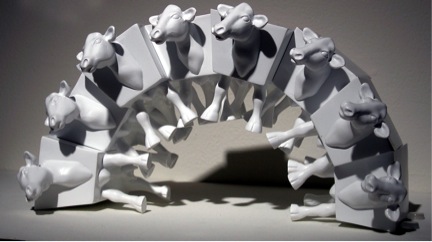
Immediate Response:
The first thing that strikes me about this piece is the arrangement of the cows. Last time I checked, it is not possible to arrange cows up in a vertical arch! However, the particularly polygonal bodies of Van Ness’s cows allows them to fit together like a puzzle as they support each other, seemingly defying the laws of physics as they do so. I also notice that the stark background and colors of the cows themselves are completely blank. There are not even any spots on the cows, which, in my mind, is one of the defining characteristics of a cow.
Objective Description:
This image shows white objects on a white background. The objects appear to be altered forms of cows. There are eight of these cows stacked up against each other, forming a vertical arch. Each cow appears to be exactly the same. The center of their body is a six sided polygonal form with angled edges on the sides. From this body, rather realistic body parts, including the head, legs, tail, and udder extend. The additional body parts do not blend into the polygonal form with any sense of curve. It is as if they were simple mounted on a block in a space that looks appropriate for a cow.
Technical Decisions:
The technical decisions made on this piece make it feel less like actual cows, and more like what they actually are: computerized renders of a creature that were edited and printed in multiples. There is no variation between each cow, which immediately feels unrealistic. Of course, the small size (only a few inches tall) and body shape of the cows contributes to this as well. It is a shape that doesn’t look like could ever be found in the natural world, but rather must have been fabricated using digital software for the sake of convenience in fitting these cows into the arch they form. There is no attempt at hiding this artificiality of these cows, as they are not painted or even placed in a faux-natural setting. They are simply printed in foam core and coated in a plain white resin.
The Work in the World:
This piece actually reminds me a lot of the Rare American Rhinocercow sculpture project I worked on last year. In that project, I made duplicates of a rhinoceros form through a mold-making process and then altered them to take away part of what made them rhinoceros (incidentally making them more like cows in the process) by removing their horns and painting them in a different way. Van Ness does something similar by altering these cows in a way that takes away part of what makes them uniquely cows. Because of his use of digital rendering, he has a more overt way of showing the artificiality of these imaginary creatures than what I did. These feel even more as though they could be marketed and sold as children’s toys, because of their lightweight material and small size, as well as the stacking capabilities.
The Story It Tells:
It seems as though David Van Ness is using these stackable cows to imagine a future where we can modify creatures and objects at will. I think that realistically, they won’t be able to be modified in such a clearly digitized and polygonal way, at least for some time. This works seems like an exaggeration of the genetic engineering that is being experimented with currently. Of course, once we learn more and more about tweaking parts of animal or plants, what exactly is going to stop us from turning things into conveniently stackable polygons, that eschew natural curves and details from straightforward efficiency? What practical use will unique colors and patterns of these creatures serve, when they can more easily just be blank canvases for our creations?
ArtsXpose 2-Eric
ArtsXpose 1-Eric
Earbuds-Eric
What are the U and V values in rebuild, and is there a limit of how much you should put in?
What is sweep 1?
How do you change materials between different parts of an object, aside from having a bunch of different layers?
Exercise 1- Eric Schroeder
Eric Schroeder
Your name:Eric Schroeder
Your major: Studio Art/Creative Writing
Please list a few of your interests, sports you play, or other activities you’re involved in (on or off campus).
Writing and Art, Gallery Docent
Why are you taking this class? What do you most want to get out of it?
I wanted to give digital a sculpture a try in order to see if it would be suitable to incorporate as an early step for making a form in my physical 3D sculptures.
Are there any particular topics or techniques that you’re hoping to learn about in this class?
The transition from the computer to the physical world, using 3D printers, etc.
Bucknell email address:
fws006@bucknell.edu
Cell phone number:
2012067796
Cell phone service provider:
Sprint
